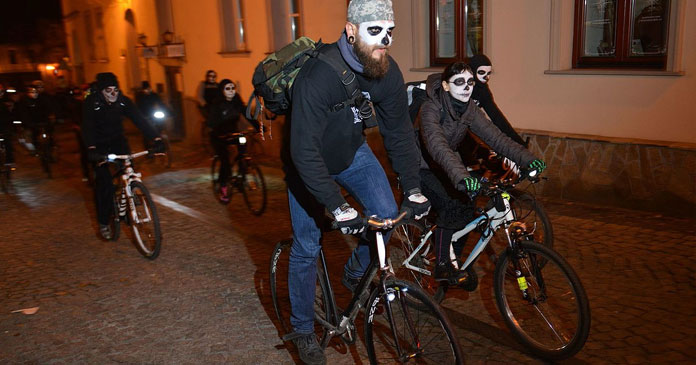When we think extreme sports, we think skateparks, halfpipes, trials courses, mountainsides, bridges and skyscraper roofs. We don’t think crowded city streets.
If you live in any major metropolis, from New York to Mexico, however, chances are one of the most daring sports you’ve never heard of is happening right under your nose.
Alleycat bike racing is a full-speed, checkpoint-collecting, car and people-dodging event that takes place on the crowded thoroughfares of some of the largest urban centers in the world.
Though it’s been around on a small scale since the late 80s, it’s now gaining prominence because of former Alleycat racer Lucas Brunelle’s documentary, Line of Sight.
Released July 1st at New York’s Bicycle Film Festival, the expose is comprised mostly of footage Brunelle captured over the past 10 years while riding with two cameras strapped to his helmet, the New York Post reports.
Brunell’s documentary (and the video below) give us a look into what seems like one of the most thrillingly dangerous games around (so dangerous, in fact, that it’s less-than-legal in many areas), but they leave us wanting more.
Where did Alleycat racing start? What are the rules? Who can compete?
Sport Origin
Toronto was the birthplace of Alleycat racing in October of 1989, when the first “Alley Cat” event was held and competitors were comprised solely of bike messengers (heart-stopping experts at the old gridlock bob-and-weave).
The tradition stayed local until 1993, when groups of racers connected with other messengers from around the world at the inaugural Cycle Messengers World Championships (CMWC) in Berlin.
The CMWC provided the captive audience enthusiasts needed to globalize their sport. Now, Alleycat races can be found around the world, from the Americas to Europe to Asia, and competitors range from pro messengers to weekend warrior urban cyclists.
Race Types
The competitive tenor of a race is largely dependent on whether it’s organized as a celebratory “come one, come all” event or more elite-focused challenge structured around elimination and winner’s bragging rights. In either capacity, there are four main permutations of race. Instead of wearing jerseys, riders stick numbered playing cards in their wheel spokes.
Checkpoint: A rider in a checkpoint race will only be given his first checkpoint destination at the competition’s start. Once he arrives at that point, he’ll be given his second destination, and so on, like a bike messenger making deliveries. He who first completes all the checkpoints wins. Riders can use any route they want to make their rounds. Expert geographic familiarity is a big plus.
Task Checkpoint: There’s only one element here that’s different from a traditional checkpoint race. At each checkpoint, riders must perform a task before being given the location of the next checkpoint. Tasks can be physical (running up stairs, doing pushups, taking a shot of hot sauce) or mental (answering trivia, for instance).
Checkpoints Up Front: Riders receive a full list of checkpoints about 30 minutes prior to the start of the race and can plan their routes.
Point Collection: Riders are given a list of checkpoints and made aware prior to the race that each checkpoint is worth a certain number of points. This clear opportunity for prioritization may dictate a time-crunched rider’s strategy.
Competitions
Much like the TEVA Summer Mountain Games, many Alleycat competitions have an all-inclusive approach to competition. Anyone with heart and a pressing interest in tempting fate can pony up a small entrance fee and grant themselves the opportunity to harness the rush of their lives.
(Sometimes bike parts and cash are also awarded.) Though city authorities are often wary of the danger of Alleycat races, event organizers usually place liability on the individual. Disobeying traffic laws as part of a decision to throw caution to the wind is never (expressly) encouraged.
The North American Cycle Courier Championships, now heading into its fifth year, is probably the most nationally visible Alleycat event, but more endeavors from New York’s Brooklyn Bridge Battle to charity-themed Global Warming Alleycat races held simultaneously across the world provide plenty of opportunities for riders of all professions and skill levels to join in the fun. If you decide to sign up, we bet you’ll have a blast. Just be careful.



